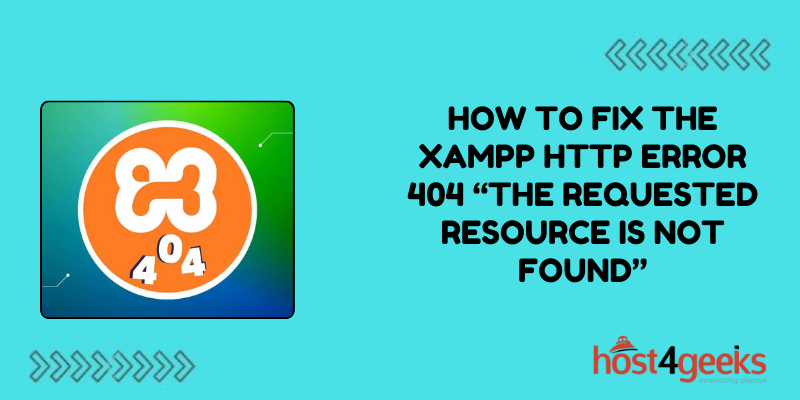In the realm of web development, encountering errors is inevitable, but it’s the ability to troubleshoot and resolve them efficiently that sets apart proficient developers.
One of the commonly encountered errors, particularly for those using XAMPP as their local server environment, is the HTTP Error 404: “The Requested Resource Is Not Found.”
This error can be frustrating, disrupting the workflow and hindering progress. However, with the right approach and understanding, it can be swiftly addressed, ensuring smooth development processes.
In this short guide on how to fix the XAMPP HTTP Error 404 “The Requested Resource Is Not Found”, we’ll explore into the significance of fixing this error, followed by a step-by-step guide on resolving it, along with the associated pros and cons.
Significance of Fixing the XAMPP HTTP Error 404:
The significance of resolving the XAMPP HTTP Error 404 lies in maintaining an uninterrupted workflow and ensuring the seamless functioning of web development projects.
Here’s why fixing this error is crucial:
1. Enhanced Productivity:
Addressing this error promptly prevents downtime and allows developers to focus on their tasks without interruptions, thereby boosting productivity.
2. Improved User Experience:
If the error occurs on a live website, resolving it promptly ensures that visitors have access to the intended content, enhancing user experience and preventing potential loss of traffic or revenue.
3. Professionalism:
Demonstrating the ability to troubleshoot and fix errors reflects positively on a developer’s professionalism and expertise, instilling confidence in clients and stakeholders.
4. Learning Opportunity:
Understanding the root cause of the error and resolving it provides valuable learning experiences, empowering developers with additional skills and knowledge for future projects.

Step-by-Step Guide to Fix the XAMPP HTTP Error 404:
Now, let’s walk through the process of resolving the XAMPP HTTP Error 404:
Step 1: Check File Paths and URLs:
The first step is to verify that the file paths and URLs specified in your code are accurate. Ensure that there are no typos or missing directories in the file paths and that the URLs are correctly formatted.
Step 2: Verify File Existence:
Confirm that the file or resource being requested actually exists in the specified location. Sometimes, errors occur due to missing or incorrectly referenced files.
Step 3: Restart XAMPP Services:
Restart the Apache and MySQL services in XAMPP. This action can often resolve configuration-related issues that may be causing the 404 error.
Step 4: Check .htaccess File:
Inspect the .htaccess file in your project directory, if present, as it might contain directives that affect URL rewriting or access to certain resources. Ensure that the directives are correctly configured and not inadvertently causing the error.

Step 5: Clear Browser Cache:
Clear your browser cache and try accessing the resource again. Cached data sometimes interferes with the loading of updated content, leading to 404 errors.
Step 6: Update XAMPP and Dependencies:
Ensure that you are using the latest version of XAMPP and any relevant dependencies such as PHP, Apache, or MySQL. Updating to the latest versions can resolve compatibility issues and bugs that may be causing the error.
Step 7: Enable Mod_rewrite (For Apache):
If you’re using Apache as the web server, make sure that the mod_rewrite module is enabled. You can do this by uncommenting the line `LoadModulerewrite_module modules/mod_rewrite.so` in the httpd.conf file and then restarting Apache.
Step 8: Check Virtual Host Configuration:
If you’re using virtual hosts in your XAMPP setup, double-check the configuration settings in the httpd-vhosts.conf file to ensure that the document root and other directives are correctly specified.
Step 9: Verify Permissions:
Check the file permissions for the directories and files involved. Ensure that the Apache user (typically ‘www-data’ or ‘apache’) has the necessary permissions to access the files.

Pros and Cons:
Pros:
– Swift resolution of the error minimizes downtime and disruption to development workflows.
– Enhances productivity by allowing developers to focus on tasks rather than troubleshooting.
– Demonstrates professionalism and expertise to clients and stakeholders.
– Provides valuable learning opportunities for developers to expand their skill set.
Cons:
– Resolving the error may require technical expertise, especially for complex configurations or coding issues.
– In some cases, identifying the root cause of the error may be time-consuming.
– Incorrectly applied fixes could potentially lead to other issues or security vulnerabilities if not thoroughly tested.
Conclusion:
In conclusion, the XAMPP HTTP Error 404: “The Requested Resource Is Not Found” is a common yet significant obstacle in web development.
By understanding its significance, following a systematic troubleshooting approach, and weighing the pros and cons of various solutions, developers can efficiently address how to fix the XAMPP HTTP Error 404 “The Requested Resource Is Not Found”, ensuring smooth and uninterrupted progress in their projects.

